#du polignac
Text

Im caught up enough now to know the basic plot beats of Scene Zero. Did I like it..? ehhh… but the thought of Mabayu and Mami becoming witches together, now thats better!
#madoka magica#puella magi madoka magica#pmmm#witch#madoka magica witch#familiar#madoka magica familiar#my art#magia record#Scene zero#scene zero spoilers#mabayu aki#candeloro#itzli#du polignac
65 notes
·
View notes
Photo



“They are very close. There is a lot of affection between them. Marie considers her to be a little bit like her little sister”
Roxane le Texier on the relationship between Marie Antoinette and Olympe du Puget
#1789 les amants de la bastille#marie antoinette#musicaltheatreedit#musicalgifs#theatreedit#europeanmusicaledit#theatrenet#perioddramaedit#weloveperioddrama#perioddramasource#ch: marie antoinette#ch: olympe du puget#ch: polignac#actress: tatiana matre#actress: Roxane le Texier#actress: Camille Lou
86 notes
·
View notes
Text

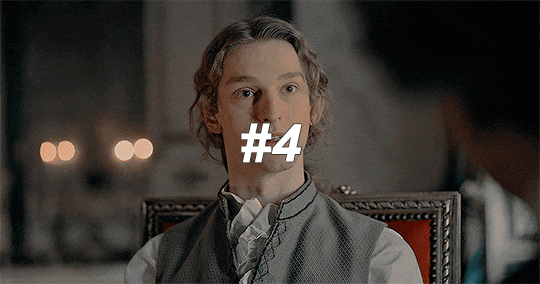
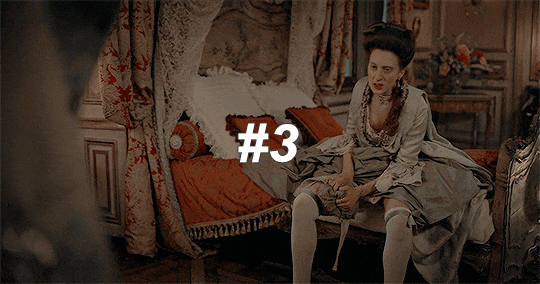


Best scenes of Marie Antoinette Season 1 according TO ME! (Ranked)
#marie and louis#louis and marie#marie antoinette pbs#marie antoinette#marie antoinette 2022#madame du barry#marie antoinette and louis#enemies#yolande de polignac#myedits#my edits#louis xvi#period couple#period drama#couple goals#dauphin#king of france
41 notes
·
View notes
Text
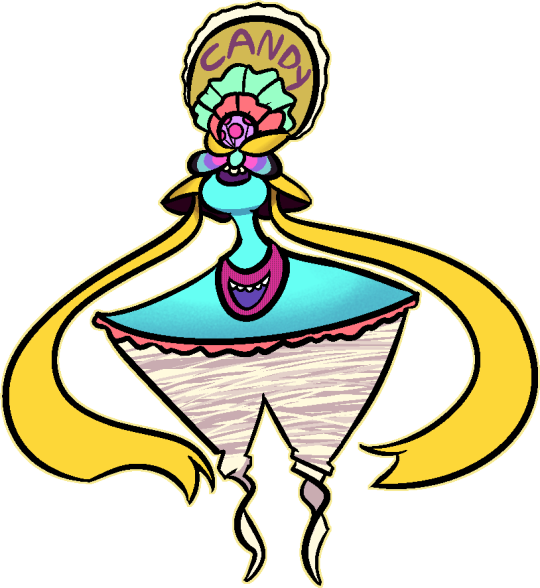
standing art i did of candeloro recently! i didnt feel like fitting her whole name in runes on her silly little bonnet, sorry.........
#madoka magica#puella magi madoka magica#madoka magica witch#candeloro#pmmm#angel arts#candeloro du polignac
12 notes
·
View notes
Text
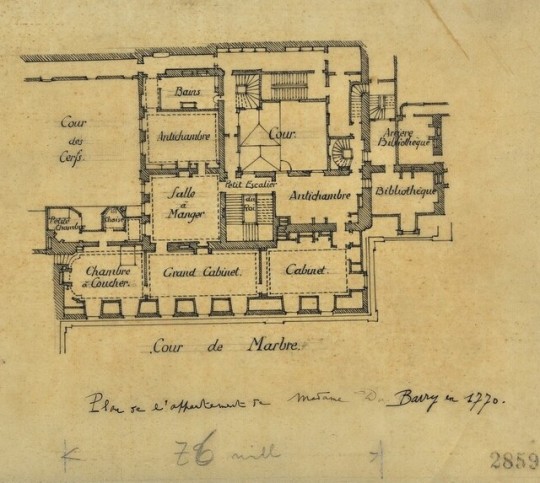
The plan for Madame du Barry's apartments in 1770. Note that she had both a chaise room (for toilet facilities) and a bain/bathroom for bathing. Du Barry's bathroom had running plumbing, a feature which Louis XV, who was known for being very strict when approving plumbing construction for bathrooms, denied to his own daughters before approving for his mistress.
Courtiers who lived at Versailles who had the space for dedicated bathrooms (which at the time were for bathing only, as bathrooms were meant to be luxury spaces, not somewhere you'd put your commode!) had to apply to the king for the construction of running plumbing.
Under Louis XV, running plumbing appeals from courtiers were rejected on the basis that he only intended to approve this type of construction for royal apartments due to the expense--except in the case of his mistresse. And he didn't always approve such requests for members of the royal family (ie, his daughters).
Under Louis XVI, approval for plumbing was notably looser. We know that the apartments of Marie Antoinette, Louis XVI, Madame Elisabeth, the comte and comtesse de Provence, the three daughters of Louis XV (Mesdames); the comte and comtesse d'Artois; and select courtiers, including the queen's favorites, the princesse de Lamballe and duchesse de Polignac, and apartments reserved for certain ministers had running plumbing. (Although Marie Antoinette's Versailles apartments did not have running plumbing until 1788-1789, and it's unknown if she ever ended up using them.)
For residents, royal or otherwise, without running plumbing but who had large enough apartments to allot dedicated bathrooms, tub bathing would have been done with tubs that were brought into these rooms and filled by servants. This is how Marie Antoinette bathed when she took immersion baths:
Campan:
... a slipper bath was rolled into her room, and her bathers brought everything that was necessary for the bath. The Queen bathed in a large gown of English flannel buttoned down to the bottom; its sleeves throughout, as well as the collar, were lined with linen.
For residents of Versailles who didn't have enough rooms for a dedicated bathroom, tubs were rolled into their regular room(s) and filled by servants.

For servants who had tiny apartments that were basically just small rooms often big enough for a bed, a desk and a drawer, they would have used wash basins for regular washing, as everyone (including aristocrats) did for daily hygiene.

Image: A well-to-do woman being washed by a servant using a wash basin.
I don't think it would have been impossible for some servants to have had standing rolling tubs that they might have split among others, as people of modest means outside of Versailles would have done. But since documentation of 'lower servant' life at Versailles is limited, it's hard to say. They could have also gone to nearby rivers or lakes to bathe if they wanted full immersion baths. Louis XIV was known for bathing in rivers, especially after the hunt.
People, particularly aristocratic women who could afford specialized pieces like this, would have also used bidets to regularly clean their private parts.


Oops I just meant to add the note about Du Barry getting running plumbing when Louis XV rejected his own daughters' requests for running plumbing, but have this other information too.
I am slowly working on a proper article about the myriad of popular culture myths about Versailles and hygiene, hopefully I will be able to sit down and force myself to finish it soon. Working on this particular article has definitely forced me to re-evaluate the general lack of solid historiography on the subject, even from historians that ought to be trusted to analyze and vet sources more seriously.
#versailles#french history#18th century#madame du barry#louis xvi by comparison was like#you get plumbing! you get plumbing! and you get plumbing!
124 notes
·
View notes
Text
THIS DAY IN GAY HISTORY
based on: The White Crane Institute's 'Gay Wisdom', Gay Birthdays, Gay For Today, Famous GLBT, glbt-Gay Encylopedia, Today in Gay History, Wikipedia, and more … April 19



1759 – August Wilhelm Iffland the German actor, playwright and librettist was born on this date (d.1814). Iffland was a powerful force in the German theater of the 18th century, even though his plays are generally unknown outside his native country.
In 1810, he was "outed" by Heinrich von Kleist, the poet, author and playright. Kelist offered August Wilhelm Iffland, who at that time was the director of the Nationaltheater, the chance to stage his play Käthchen of Heilbronn. When Iffland refused, Kleist branded him a homosexual.
On 1 October 1810, Kleist surprised the people of Berlin by setting up a daily newspaper. The Berliner Abendblätter appeared every day except Sundays for half a year in the convenient octavo format at a price of eight Pfennigs. The newspaper provided a diverse mixture of information to suit every taste: police announcements, military anecdotes, poems, aesthetic essays such as Kleist's famous article "On the Marionette Theatre", critical looks at the Prussian government, and polemic attacks on Iffland's theatre and his homosexuality. Kleist's paper was shut down by Germain authorities and the attacks ceased. Kleist committed suicide soon after.
Iffland died in Berlin on 22 September 1814. A bronze portrait statue of him was erected in front of the Mannheim theater in 1864. A street in Berlin is named after him. The Iffland-Ring bears Iffland's likeness, and is borne by the most important German-speaking actor, as decided by his predecessor.

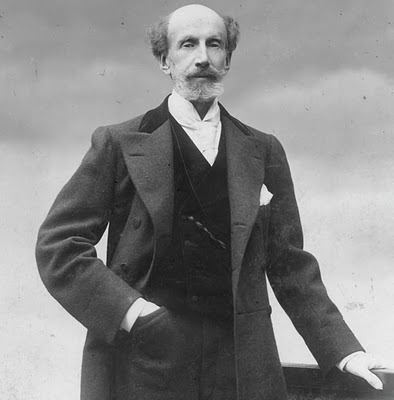
1834 – Prince Edmond De Polignac the French composer was born on this date (d.1901). A descendant of one of the more illustrious families of France. His father Auguste Jules Armand Marie, Prince de Polignac (1780-1847) was the Minister of State in the Restoration government of King Charles X, and was the author of the Thirty Ordinances in 1830, which revoked the Constitution, suspended freedom of the press, and gave the king extraordinary powers, including absolute power in the name of "insuring the safety of the state".
In 1875 a new friend entered de Polignac's life, Comte Robert de Montesquiou, a beautiful and intelligent man twenty-one years his junior. They shared many interests, and began an intimate relationship at that time. In his later years, Montesquiou used his wit to shield himself from sincere emotional interaction. He is remembered as a model for Des Esseintes in Huysman's A Rebours, and the Baron de Charlus in Proust's À la recherche du temps perdu. Through Montesquiou's circle, Polignac made the acquaintance of Elisabeth, comtesse Greffulhe and of Gabriel Fauré, and became a member of the Société Nationale de Musique, where his compositions were performed alongside those of Chausson, Debussy, and Fauré.
By 1892, Polignac, inept with money and impoverished through investments in a series of get-rich-quick schemes, was destitute; his nephews helped him with loans, but noted that desperate action was needed. The solution they suggested was marriage to a woman of appropriate means. Polignac discussed the matter with Montesquiou, and Montesquiou with his cousin Élisabeth Greffulhe, and out of these conversations the name of Winnaretta Eugenie Singer, daughter of Isaac Singer, the sewing machine tycoon, with her marriage to Prince Louis de Scey-Montbéliard lately annulled, arose.
Singer's social status could be improved by marrying a prince, even a poor one. And the arrangement would have other benefits: Winnaretta was Lesbian and not sexually interested in men at all. She was intimately interested in music, however, something the two did have in common.
Polignac asked the Comtesse Greffulhe to sound out Madame Singer on the subject of a mariage blanc (unconsummated marriage), in which each partner would have their own bed but would share artistic interests. Montesquiou, who collaborated with Winnaretta on some artistic projects, asked her to speak with Madame Greffulhe, and there the arguments were reviewed; her social position, compromised by divorce, would be improved by an alliance with one of the oldest and most distinguished aristocratic families in France; with the thirty-one year age difference, and the predilections of the bride and groom, Winnaretta would be free to lead her personal life as she wished, with no sexual demands from Edmond.
The advantages clear, a friendship and affection grew. In November 1893, Edmond proposed marriage to Winnaretta, and she accepted, a year after the idea had first been broached. On 15 December 1893 the couple were married by the Abbé de Broglie in the Chapelle des Carmes. The union received the blessings of Pope Leo XIII.
Montesquiou felt slighted when Edmond was not sufficiently grateful, and the friendship was irrevocably broken.
Ed. Note: The house of Polignac is also (technically) the current Princely House of Monaco; Prince Ranier (late husband of Grace Kelly) was the son of a Monagasque princess and a Polignac. For patriotic reasons, the princely house still keeps the name Grimaldi, though it has passed through the female line a couple of times. This is certainly a family with an interesting past and present.


1913 – The Illinois Supreme Court rules that cunnilingus is not a "crime against nature" under that's state's sodomy law, even though the Court had ruled fellatio to be one due to the state's unusually broad language.


1946 – Tim Curry, British actor and famed on-screen outerspace transvestite was born on this date. Curry's first full-time role was as part of the original London cast of the musical Hair in 1968, where he first met Richard O'Brien who went on to write Curry's next full-time and perhaps still most famous role, that of Dr. Frank-N-Furter in The Rocky Horror Show. Originally, Curry rehearsed the character with a German accent and peroxide blond hair, but the character evolved into the sly, very upper-class English mad scientist and transvestite that carried over to the movie version of The Rocky Horror Picture Show and made Curry both a star and a cult figure.
He continued to play the character in London, Los Angeles, and New York until 1975. For many years, Curry was reluctant to talk about Rocky Horror, feeling that it was a trend that had gone too far and had distracted attention away from his later roles.
On 23 May 2013, Curry was reported to have suffered a major stroke at his home in Los Angeles. Although many sources suggested the stroke had made it difficult for him to speak, his longtime agent Marcia Hurwitz told the Daily Mail "Tim is doing great," and that 'He absolutely can speak and is recovering at this time and in great humour'. Shortly after the initial report, Hurwitz told The Hollywood Reporter that the stroke actually occurred in July 2012, and that Curry had been going to physical therapy. As a result of the stroke, he uses a wheelchair.


1967 – The Student Homophile League of Columbia University becomes the first U.S. gay college group to obtain a campus charter. The SHL had twelve members who fought with university administrators for a year before the group was officially recognized.
Stephen Donaldson, a bisexual-identified LGBT rights activist is commemorated by a plaque in the Queer Lounge that bears his name in one of Columbia’s residence halls for spearheading the creation of the group.
When the charter was ultimately granted in April 1967, it earned media attention with the New York Times printing a story on the front page. The Columbia Daily Spectator reported that some students believed that the creation of the group was an April Fool’s joke. The group is still in existence to this day and is now called the Columbia Queer Alliance


1978 – James Franco is an American actor, filmmaker, and teacher.
His first prominent acting role was the lead character Daniel Desario on the short-lived cult hit television program Freaks and Geeks. He later played the title character in the TV biographical film James Dean (2001), for which he won a Golden Globe Award. He played Harry Osborn in Sam Raimi's Spider-Man trilogy (2002–2007). He is also known for his roles in the films Flyboys (2006), Pineapple Express (2008), Milk (2008), 127 Hours (2010), Rise of the Planet of the Apes (2011), Oz the Great and Powerful (2013), Spring Breakers (2013), This Is the End (2013) and The Interview (2014). He had a recurring role in the ABC soap opera General Hospital. For his role in 127 Hours, Franco was nominated for an Academy Award for Best Actor.
Franco volunteers for the Art of Elysium charity and has taught a class at New York University in feature filmmaking and production. In 2013, he began teaching a course in short film production at the University of Southern California and a course in screenwriting at his alma mater, University of California, Los Angeles.
In response to questions regarding his sexuality now that he has portrayed three gay characters during his acting career, he insists he finds plenty more dimensions to the characters than their bedroom proclivities. "Or, you know what," he quipped, "maybe I’m just gay."
Those rumors led to a Gawker article linking him to a New York Post Page Six blind item about a closeted gay actor, nicknamed "the Gay Rapist". Despite the victim of the alleged attack denying that it was Franco, two magazines then contacted Franco's lawyer to alert them that they might run stories suggesting his involvement, but were unable to, as at least part of their stories were fabricated. However, Gawker refused to take their article down as they were simply reporting what another outlet published and instead offered him a chance to make a comment about the speculation on its website. He declined, hoping it would die down. The actor later called the episode very offensive because he has friends who have been raped.
In I Am Michael (2014), he plays real-life figure Michael Glatze, a former gay activist who leaves his boyfriend (Zachary Quinto) behind after declaring himself straight and becoming a pastor.
Franco says of the gay content of many of his projects:
"Some of it's coincidence, or the gay aspect of the project — like Hart Crane in The Broken Tower or Allen Ginsberg in Howl — is secondary. It wasn't like, 'We need to do this because he was gay.' It's because of their art, and then their art was partially informed by their sexuality. But then with something like Interior Leather Bar or Milk, those are obviously engaging with gay themes, gay rights, gay politics. In the case of Milk, once I did that movie, it kind of opened me up to a lot of things I hadn't really thought about because they hadn't been a part of my life. Lee Daniels says that gay rights are the civil rights of our era, so I like doing a movie like Milk or Interior Leather Bar where I can bring themes and ideas I've been engaged with, and do it in such a way that those ideas are pulled into the mainstream more."
In a March 2015 interview with Four Two Nine magazine, Franco again opened up about his sexuality, commenting that it is not who you have sex with that defines your sexuality, but instead how you act. "In the twenties and thirties, they used to define homosexuality by how you acted and not by whom you slept with. Sailors would fuck guys all the time, but as long as they behaved in masculine ways, they weren’t considered gay". Franco added, "Well, I like to think that I’m gay in my art and straight in my life."


1982 – The Gay Officers Action League, Inc. is founded by NYPD Sergeant Charles Cochrane and retired Detective Sam Ciccone etablishing the first official police fraternal society in the world to represent LGBT people within the criminal justice system.
Sergeant Cochrane, a 14 year veteran of the NYPD, created shock waves by testifying before a NYC Council hearing in favor of a gay rights bill. Following the testimony of a Patrolmens Benevolent Association Vice President, who denounced the bill and declared, "I didn't know of any homosexual police officers.", Cochrane stunned all present as well as NYC as a whole by his testimony: "I am very proud of being a New York City Police Officer, and I am equally proud of being gay."
In 1987, at the persistent urging of GOAL, NYPD began a concerted effort to actively enlist qualified gay candidates. In 2002, GOAL was admitted into COPS, The Committee of Police Societies, an organization consisting of all recognized NYPD religious, ethnic fraternal organizations.
Since its ineption, GOAL has evolved not only as a fraternal organization, but also as an activist organization that represents the interests of its LGBT members in all agencies and branches within the criminal justice system.


1992 – James Scully is an American actor, best known for portraying JD in the Paramount Network series Heathers (2018) and Forty Quinn in the Netflix thriller series You.
Scully was born and raised in San Antonio, Texas. In his youth, he spent a brief period in England when his father was stationed there as a part of the United States Air Force. He later attended Otterbein University, where he earned a Bachelor of Fine Arts in musical theater. Scully was also a cycling instructor for three and a half years at SWERVE Fitness.
Prior to working in Los Angeles, Scully resided in New York performing Off-Broadway. In 2016, Scully made his acting debut in the web series drama series, Sublets. Following on from his first role, Scully later made appearances in television series, such as Quantico and 9-1-1.
He has also done commercial work for Outback Steakhouse and a public service announcement about Vicodin abuse with Riverdale actress, Camila Mendes.
In 2018, Scully starred in the main role of JD on the Paramount Network series Heathers. In January 2019, it was announced that Scully had been cast as Forty Quinn on the second season of the Netflix thriller series You.
Scully is openly gay

1995 – Arizona revises its sex offender registration law to remove sodomy from the list of compulsory registration categories, but permits judges to order registration if the defendant committed sodomy for "sexual motivation."???


11 notes
·
View notes
Note
Hello sorry to bother you but have you watched episode of Marie Antoinette? Do you mind spoiling for me please
I have watched them on stremio, french sub french.
SPOILER not so important
no girl feud between Marie Antoinette and du Barry at the beginning
focus on Chartes
focus on Lamballe
focus on Provence
SAINT GEORGES
Louis XV portaited as a lusty gran dad
only two mesdames tantes
Fersen in only 2 episode
Toinette/Louis slow burn
SPOILER important
almost every scene not follow the historical canon, only on the surface
Provence gay erasured
Saint Georges bi erasured
lesbian hints Toinette/Lamballe and Toinette/Polignac, hinting Lamballe is jealous in romantic way
Chartes tried to rape Toinette in Season Finale
Louis has a "nave scuola" in the sixth episode
Louis XV planned to marry du Barry
Noailles portaied like the villain
22 notes
·
View notes
Text
Publié le 19/06/2023 à 10:37, mis à jour le 19/06/2023 à 09:23
4 notes
·
View notes
Text
I know this will not be of interest to 99.99% of people, but this is what I have been working on and and I want answers.
On Gallica I started reading this book called "Causeries parisiennes" which is a collection of articles published in la Revue Nationale between 1861 and 1862. It was written by "Horace de Lagardie" and penciled in on the title page it says "pseudonym of Madame de Peyronnet."
Who was Madame de Peyronnet? That is the question.
In the "about" section of the website, the author is listed as "Caroline Philippine Élisabeth Bertin Ctesse de Peyronnet." My problem is that I cannot find anything else about Caroline Philippine Élisabeth Bertin Comtesse de Peyronnet (except other sites like amazon and walmart which list her as the author of "Causeries parisiennes"-- and one exception which I will get to later).
Okay so maybe Caroline Philippine Élisabeth Bertin is just a forgotten person, no wikipedia page, no geneology information, didn’t write any other books or articles, maybe there isn't anything else about there about her.
Possible. But consider:
1. I found a book from 1884 called "Les Pseudonymes du jour" which confirms that Horace de Lagardie is the pseudonum of Mme de Peyronnet.
2. Then I found an English book of literary criticism about French writers with an article from 1877 which cites an article in a British publication that same year "signed by a name which a few years since made a slight mark in French journalism,. Horace de Lagardie is, we believe, the pseudonum of a clever lady." They remark that Horace "writes English almost as well as French" and that "he may at least profess to know England exceptionally well."
3. Then I found the diary of M. E. Grant Duff he mentions a Madame de Peyronnet, noting that her grandfather was "one of Polignac's colleagues," and who was living in England in 1869 before going back to France, after which he notes that she is undergoing hardship due to the Franco-Prussian war (M. de Peyronnet died at the siege of Paris.) He also referenced "the brilliant writer who veils a real name under the nom de plume of Horace de Lagardie." This didn't give me a first name for Mme or M Peyronnet but it does tentatively link Mme. Peyronnet and Horace.
4. By searching "Mme de Peyronnet" I found the diary of Mary Enid Evelyn (Lady Layard). From reading that I found that she spent time with the Peyronnet family in England and in France, documented in entries dated between 1869 and 1891. She particular spent time with the two sisters Isabel (who would become Lady Sligo) and Madeleine. Horace can’t be Isabel or Madeleine because they were both unmarried at the relevant time (mademoiselles) but she also mentions Mme de Peyronnet.
5. Okay now with the help of English genealogy websites I found Isabel Raymonde Browne (de Peyronnet), wife of the George John Browne, 3rd Marquess of Sligo, sister of Marie Madeleine Claire de Peyronnet and daughter of Georgiana Frances de Peyronnet and Paul Louis Jules de Peyronnet (who was apparently the son of Pierre-Denis, Comte de Peyronnet, who is the last Comte de Peyronnet with a Wikipedia page that I can find but it doesn't include anything about his family.) (They also had a third daughter, Laura de Peyronnet, who married Lord Arthur Russell.)
6. Well Caroline Philippine Élisabeth Bertin doesn’t have much of an online presence by Georgina Frances actually has a Wikipedia page. She was a British journalist who was a correspondent for The Times during the Franco-Prussian war.
7. There is also an entry about her on the website for the Centre for the Study of the Legacies of British Slavery. In states:
Georgina Frances Whitfield, born in the West Indies 1815 [. . .] Moved to England with her mother not long after her birth, then moved to France in 1822 or 1823. Married Vicomte Jules de Peyronnet (1804-1872) in London 03/02/1835. His father opposed the marriage and stopped his allowance. '[T]hanks to the income from the Whitfield sugar plantations, however, they were able to tour Europe in style. Later, with the gradual abolition of slavery in the English [sic] West Indies, this source of revenue began to dry up, and they (and her mother) moved to St Vincent in 1840.' They returned to France in 1844. Wrote for Edinburgh Review etc., then for The Times during the Franco-Prussian war. 'She probably did much of the translation work for her husband's French edition of Macaulay's History of England (1861).'
At this point I am almost certain that Georgina Frances, not Caroline Philippine Élisabeth Bertin, is Horace de Lagardie.
Going back to source 2, it would make sense that she raised in England, not France, so no wonder her English was as good as her French and she knew England very well.
With regards to source 3. Duff’s notes about her being in France during the Franco-Prussian War line up with her being a correspondent for the Times.
Duff mentions her relation to a man who worked with Polignac; see source 5, her father-in-law was charged with treason alongside Polignac.
As for source 7, it provides more cooboration about why she knew English and French so well and that she was able to translate her husband's book.
8. And now, I come to an article in the New Zealand Slavonic Journal from 1988 about Russian writer Ivan Turgenev. In a section about Turgenev's relationship with Lamartine, we learn that the two were introduced by "an intelligent and beautiful cosmopolitan literary lady." Apparently it is much debated who this lady was. This author's suggestion?
"Georgine Frances, vicomtesse de Peyronnet" who published "under the pseudonum Horace de Lagardie in La Revue nationale and Le Journal des debats."
"Mme de Peyronnet was found wherever opposition to Napoleon III or similar autocracy dared to raise its head."
Furthermore, a review of a book by Turgenev was published in la Revue nationale et étrangère and reprinted in Causeries Parisiennes (vol. 2). So Georgina knew Turgenev. And Horace de Lagardie wrote about Turgenev.
"She is found mentioned in many accounts of the period, such as those by Nassau William Senior and Mountstuart E. Grant Duff, but see especially Edouard Grenier, Souvenirs litteraires, Paris, 1894, p. 22." (I did especially see Souveniers litteraires, page 22 but all it did was confirm that Georgina de Peyronnet knew Lamartine, not that she was Horace. Also idk why the author writes “Georgine” instead of “Georgina.” All the other sources cited by this author are in Russian so I can’t look there.)
So yeah, I am not sure how this author can say for sure that she was Horace de Lagardie but all the circumstantial evidence I have presented 1-6 make me lean towards that. Now, onto what I believe to be the original instance of Caroline Philippine Élisabeth Bertin Comtesse de Peyronnet being called Horace de Lagardie.
9. Again, there is no biographical information to be found about this supposed person. The only place where I have been able to find a mention of "Caroline Philippine Élisabeth Bertin Comtesse de Peyronnet" is in an edition of the diary of Xavier Marnier which was published in 1968 with notes by Eldon Kaye, who was a French professor at Carleton University.
Here is an article from 2010 about that publication (with bracketed translations by me)(I only have access to the first page of the article though):
This edition was received enthusiastically: Kaye was awarded a silver medal by the Académie Française for his '[long and patient work presenting the text]'; Andre Billy, writing in Le Figaro commented on Kaye's having '[taken so much care to decipher the manuscript]', and L'Est Republicain, a well-respected regional daily newspaper, claimed that Kaye '[presented and annotated it with an admirable precision and minutia].' Ironically, in view of these laudatory comments, a comparison of the manuscripts with Kaye's published version shows that Kaye's work is highly inaccurate and offers only a very approximate and often deformed view of what Marnier actually wrote. Although no reviewer has hitherto suggested the extent of Kaye's incompetence, the quality of the edition has previously been questioned by both the late Pierre Moreau and Andre Monchoux. Moreau criticizes the arrangement of the texts, but limits his criticism to two cases which '[will make one understand why the edition did not resolve all the problems I found with the manuscript].' Monchoux points out a few ‘[spelling mistakes]’ and asks, perhaps disingenuously,
(and that's where my preview ends)
Your honor, I rest my case.
There is lots of circumstantial evidence that Georgina Peyronnet was Horace de Lagardie, plus the scholarly article about Turgenv, but there is only source I can find which says Caroline Philippine Élisabeth Bertin was Lagardie and that source does not seem trustworthy. So if the Kaye manuscript is the source of the attribution, then it could possibly be wrong. But if it isn’t then I have just wasted an afternoon.
6 notes
·
View notes
Note
So I was watching Sophia Coppola's Marie Antoinette and the scene where she's at the opera and is the only one clapping while everyone else glares at her has always struck me. This time I was wondering why the nobility came to hate her. I understand the resentment from the common people due to her lifestyle + propaganda, but them? What was their reasoning?
Coppola's movie is historically inacurrate on many levels but it did get a few things right, which they sprinkled here and there throughout the movie, and in my opinion this scene is one of them.
Marie Antoinette's distrust and animosity with the court/nobility was a long lasting feud that ran up pretty much from her arrival in France to her death. It just got progessively worse and worse because she became exponentially more reclusive and protective (of herself, her friends and her children, and i believe her husband as well to some extent). People like to believe Mme du Barry was an airhead and an harmless whore but she had her own faction at court and her own political agenda; the way Marie Antoinette slighted her was not without consequences. The same thing happened with people like Mme de Noailles; slighting her and making fun of her in public and behind closed doors alienated the oldest families at court, which also had long lasting consequences. Her progressive seclusion, over in Trianon notably, meant that there was an even more exclusive circle these people were not a part of (we see a scene like this in the movie i believe, i remember someone complaining to Mercy(?) about it), and we all know what it means to deny literal millionaires access to exclusive circles.
Bear in mind that the propaganda wasn't only meant for the commonfolk. I don't think the common people cared nearly as much about the Queen made-up affair, first with the Princesse de Lamballe, then Mme de Polignac, as much as the nobility did. Sure, the common people thought about her as a deviant woman indulging in illicit sexual affairs, but the nobility was forced to face the idea that if these were true, then either Lamballe or Polignac were favorites you would never catch up on, ever. Louis XVI and Marie Antoinette were supposed to spend their lives ruling France, and considering their respective genes (and the general lack of transparency regarding medical records of monarchs) they could have very well ruled well into their 70s. Imagine, fifty more years, of being slighted at every turn? with the Polignacs running the show? It was bad.
The second opera scene is there to emphasize that the grace period is most definitely over, that the charming little antics of the Austrian Dauphine are and will no longer be tolerated now that she's Queen of France; she made the choice to consciously turn them and their system down and now she has to lie in the bed she's made for herself. Cinematically speaking it also dramatically plays with the fact that she's a changed woman in the midst of life tragedies and bigger-picture events, etc etc.
12 notes
·
View notes
Photo









Candeloro and Du Polignac icons
#madoka magica#pmmm#puella magi madoka magica#candeloro#du polignac#kokyo#dokama#witch#familiar#madoka magica witch#madoka magica familiar#icon#icons
69 notes
·
View notes
Text
Lady Oscar
I honestly love only the women in Lady Oscar...Of course Lady Oscar is my number one...but I also loved Jeanne, who tried to imitate the nobels, but was not able completely cold-hearted...so she did not kill Nicole, even though she knew that it would break her neck one day...
Even Madame Polignac is an interesting figure...like du Barry she would do anything for power....Just that du Barry knew poverty and had to prostitute herself for it...
Poor Charlotte who was a 12 year old child, whose mother tried to marry a pedophile and she hated it so much that she committed suicide.
Rosalie, who is the illegitimate daughter of Mme Polignac and Jeanne´s sister, who tried to take revenge on her own mother, because she killed her foster-mother.
I do think that Marie-Antoinette is such a beautiful character, even though she is not exactly my favorite.
The men are rather pale, even Andre...Maybe Girondelle, because he thought that he could marry Lady Oscar...and that is a joke in itself.
1 note
·
View note
Note
Fan Children Time!
The Du Polignac Twins, Momoiro and Akaiiro (Sayaka, Ophelia, Candeloro)
These twins are near identical, with the only things different (Their Hair being opposite ombrés with Momoiro’s being pink to red, and Akaiiro having Red to pink). They share Candeloro’s cooking skills, with Momoiro specializing in drinks and Akaiiro specializing in main dishes. They both share a similar sense of rhythm, and for an example, let’s say they try to slap something at the same time. If two normal people did this, there would be some form of noticeable delay. With the Twins, there is little to no delay, with both of their slaps hitting the thing at exactly the same time. Momoiro takes after Ophelia more, being more reckless and a tad bit snooty, and Akaiiro takes more after Candeloro and Sayaka. Momoiro has regenerative abilities and Akaiiro has illusions.
Zavier/Zoe (Sayaka, Ophelia, Candeloro)
The younger sibling of the twins. A chuunibyou. Often dramatic and speaks like Candeloro’s secret diary about exploring the walls. Says he is, and I quote “The fallen Angel of the great gates of paradise, destined to wander this mortal plane in this feeble form”. Probably going to cringe over this in later years. Although he can be outlandish and kind of cringey, he is sincere and kind, and those who can actually translate and understand what he says half the time can confirm his genuine good nature. Has Candeloro’s binding abilities but instead of ribbons, he uses chains. A trans icon and probably drew a skull on his binder. Has a blossoming career in fantasy novels.
Circe (Kremihild Gretchen, Homura)
A young girl who unknowingly has the power to reduce the planet to dust. Luckily, very mellow and chill. Unfortunately, she developed narcolepsy, leading her to fall asleep during the day and often suffers from cataplexy. She takes meds for it and is still very bright and cheerful, and will kick you in the balls if you piss her off. She desires to work with animals, but first has to learn how to control her overflowing powers, as she once tried to pick a plate of the floor and with one touch, turned it into ash. Has a weaker version of Homura’s powers, as she can slow down and speed up time. Can summon a fluffy cloud to fly around on.
Kenshin the Clara Doll (Homulilly, Madoka)
Considered one of the unofficial Clara Dolls by the other Dolls. Represents Devotion, in contrast to the negative representatives of the other Clara Dolls. Stubborn as a mule, and is almost impossible for her to agree with you if her opinion is different than yours. She is wildly determined and will not stop until she gets to her goal, and these goals can range from minuscule and harmless to lofty and near impossible. However, she will gladly drop everything to help her family or the other Clara Dolls.
OHHHHHH THEYRE DELIGHTFUL,,,
15 notes
·
View notes
Note
Bunny just smiles back as he hugs him back bunny and we also have go to candeloro gingerbread house and have a tea party there it was so cute you trying to say the du polignacs names then you where a baby they are hee minions just to let you know
*Haruki lets out a hum of understanding before he chuckles in amusement at his antics.*
Haruki: Oh, I see. Yeah, I remember reading about them a while ago. (...) Heh yeah, I couldn't pronounce anything worth a crap when I was little.
0 notes
Photo

A portrait of Aglaé de Polignac, duchesse de Guiche by an unidentified artist, circa 1783. [source: Musée Cognacq-Jay, le goût du XVIIIe]
48 notes
·
View notes